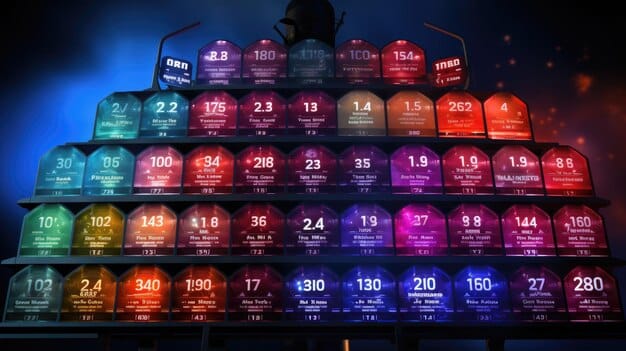US Esports Viewership Trends: Which Games Dominate Q3?

US esports viewership trends in the current quarter reveal that established titles like League of Legends and Counter-Strike: Global Offensive continue to dominate, while emerging games struggle to capture significant audience share.
Understanding US Esports Viewership Trends: Which Games are Dominating in the Current Quarter? is crucial for stakeholders seeking to capitalize on the booming esports industry. Viewership numbers not only reflect a game’s popularity but also drive revenue through advertising, sponsorships, and media rights.
Top Esports Games by Viewership in the US
Esports viewership in the US is a dynamic landscape, constantly shifting with new game releases, updates to existing titles, and the ebb and flow of professional esports leagues. Several factors influence viewership, including the game’s inherent appeal, the quality of its esports ecosystem, and the marketing efforts of game developers and tournament organizers.
In this section, we’ll delve into the games that currently command the largest audiences in the US esports market, analyzing their key strengths and the reasons for their sustained success.

League of Legends: The Enduring King
League of Legends (LoL) has consistently ranked among the top esports titles globally, and the US is no exception. Its complex gameplay, strategic depth, and highly competitive professional scene contribute to its popularity.
The League of Legends Championship Series (LCS), the premier LoL league in North America, attracts a large and dedicated fanbase. International tournaments like the Mid-Season Invitational (MSI) and the World Championship further boost LoL’s viewership numbers in the US.
Counter-Strike: Global Offensive (CS:GO): A Tactical Shooter’s Reign
CS:GO, a mainstay of the esports scene for over a decade, continues to hold a strong position in the US market. Its tactical gameplay, skill-based mechanics, and fast-paced action appeal to both casual viewers and hardcore fans.
Major CS:GO tournaments, such as the Intel Extreme Masters (IEM) and the ESL Pro League, draw significant viewership in the US. The game’s thriving community and active modding scene also contribute to its long-term appeal.
- Consistent appeal due to skill-based gameplay.
- Popularity of established, high-profile tournaments.
- Active community and modding scene ensure longevity.
- Regular updates balancing gameplay add to the experience.
League of Legends and Counter-Strike: Global Offensive maintain their dominance with enduring gameplay and strong esports presences.
The Rise of Valorant and Other FPS Titles
First-person shooters (FPS) have always been a popular genre in esports, and several titles are vying for viewership share in the US market. While CS:GO remains a top contender, newer games like Valorant are making significant inroads.
This section examines the performance of Valorant and other notable FPS titles, exploring their strengths and challenges in attracting and retaining viewers.
Valorant: A Rising Star in the FPS Scene
Developed by Riot Games, the same company behind League of Legends, Valorant has quickly gained traction in the esports world. Its blend of tactical gameplay, unique character abilities, and a polished esports infrastructure have resonated with players and viewers alike.
The Valorant Champions Tour (VCT), Riot Games’ official esports circuit for the game, has contributed to Valorant’s growing viewership in the US. The game’s accessibility and engaging spectator experience make it an attractive option for new esports fans.
Call of Duty: A Console-Centric Powerhouse
The Call of Duty franchise has a long history in esports, particularly on consoles. While its PC viewership may be smaller than some other titles, Call of Duty remains a popular esports option for console gamers in the US.
The Call of Duty League (CDL) showcases the best console players in the world, attracting a dedicated audience. The franchise’s accessibility and fast-paced action make it a consistently engaging esport to watch.
- Valorant is quickly gaining traction with a blend of tactical gameplay and unique character abilities.
- Call of Duty maintains console dominance with an established league and engaging action.
- Both try to attract new Esports into their fan base.
- Despite new additions, there is still room to grow for both.
Valorant is a rising star, while Call of Duty maintains a strong console presence, both contributing to the lively FPS scene in the US.
Mobile Esports: A Growing Force in the US
Mobile esports, once considered a niche market, are experiencing rapid growth in the US. The accessibility and convenience of mobile gaming have made it a popular option for both players and viewers.
In this section, we’ll examine the most popular mobile esports titles in the US, their viewership numbers, and the factors driving their expansion.

PUBG Mobile: A Battle Royale Sensation
PUBG Mobile has become one of the most popular mobile games in the world, and its esports scene is thriving in many regions, including the US. Its accessible gameplay, exciting battle royale format, and established tournament structure contribute to its viewership.
The PUBG Mobile Club Open (PMCO) and the PUBG Mobile Global Championship (PMGC) are major international tournaments that attract a large audience in the US. The game’s casual appeal and competitive depth make it a compelling esports option.
Call of Duty: Mobile: Expanding the Franchise’s Reach
Call of Duty: Mobile has also found success in the mobile esports market, leveraging the popularity of the Call of Duty franchise. Its accessible gameplay, familiar maps and modes, and dedicated esports scene have resonated with players and viewers.
Tournaments like the Call of Duty: Mobile World Championship attract a sizeable audience in the US. The game’s ease of access and competitive gameplay make it an attractive option for mobile esports enthusiasts.
PUBG Mobile and Call of Duty: Mobile dominate with intuitive gameplay and popular tournament structures.
The Impact of Streaming Platforms on Esports Viewership
Streaming platforms like Twitch and YouTube have revolutionized the way esports are consumed. These platforms provide a direct connection between streamers, professional players, and viewers, fostering a vibrant and engaged community.
This section explores the impact of streaming platforms on esports viewership trends, examining how they have shaped the landscape and influenced the popularity of various games.
Twitch: The King of Esports Streaming
Twitch remains the dominant platform for esports streaming, offering a wide range of content, from professional tournaments to individual streamer broadcasts. Its interactive features, such as chat and emotes, create a unique and engaging viewing experience.
Most major esports tournaments are broadcast on Twitch, attracting millions of viewers. Many professional players also use Twitch to stream their practice sessions and interact with their fans.
YouTube: A Growing Force in Esports Content
YouTube has also become an increasingly important platform for esports content, offering a mix of live streams, VODs (video on demand), and highlights. Its vast reach and accessibility make it an attractive option for both creators and viewers.
Many esports organizations and professional players have established a presence on YouTube, creating content specifically for the platform. YouTube’s monetization options and audience reach make it a valuable tool for growing the esports ecosystem.
- Twitch dominates interactive features.
- YouTube grows with diverse content and broad reach.
- Both improve the esport experience overall.
- Both platforms give content creators a platform to express themselves.
Twitch is the primary esports hub, while YouTube expands viewership with a wider array of content, both greatly enhancing the esports landscape.
Factors Influencing Esports Viewership Fluctuations
Esports viewership is not static; it fluctuates based on a variety of factors, including game updates, tournament schedules, and the overall health of the esports ecosystem.
In this section, we’ll examine the key factors that influence esports viewership fluctuations, providing insights into the dynamics of the market.
Game Updates and Meta Shifts
Major game updates can significantly impact viewership numbers. New characters, weapons, or gameplay mechanics can revitalize a game, attracting both new and returning viewers. Conversely, poorly received updates can lead to a decline in viewership.
Meta shifts, changes in the dominant strategies and tactics in a game, can also influence viewership. A fresh meta can make a game more exciting to watch, while a stagnant meta can lead to viewer fatigue.
Tournament Schedules and Competition
The timing and frequency of tournaments play a crucial role in driving viewership. Major international tournaments typically attract the largest audiences, while smaller regional events may have a more limited draw.
Competition from other esports events and entertainment options can also impact viewership. A crowded tournament schedule may dilute the audience, while a lack of compelling content can lead viewers to seek entertainment elsewhere.
- Game updates introduce excitement, but poor changes can deter viewers.
- Tournament timing and competition affect viewership numbers.
- Balance in scheduling and game design are important.
Esports viewership is impacted by the game updates and the structure of tournaments.
The Future of US Esports Viewership: Emerging Trends and Predictions
The US esports market is constantly evolving, and several emerging trends are poised to shape its future. Understanding these trends is essential for stakeholders looking to capitalize on the growth potential of the market.
In this section, we’ll explore some of the key trends and predictions for the future of US esports viewership, providing insights into the direction the industry is headed.
The Continued Rise of Mobile Esports
Mobile esports are expected to continue their rapid growth in the US, driven by the increasing accessibility of mobile gaming and the development of more sophisticated mobile esports ecosystems. New mobile esports titles are likely to emerge, further expanding the market.
The integration of mobile esports into mainstream esports events and streaming platforms will also contribute to their growth. As mobile gaming becomes more widely accepted, mobile esports are likely to attract a larger and more diverse audience.
The Growth of Niche Esports Titles
While established titles like League of Legends and CS:GO will continue to dominate, niche esports titles are also expected to gain traction. Games with unique gameplay mechanics, dedicated communities, and innovative esports formats can carve out a loyal following.
Examples include fighting games, racing games, and real-time strategy games. These titles may not attract the same viewership numbers as the top esports games, but they can offer a valuable niche audience for advertisers and sponsors.
Mobile Esport will continue to rise while niche titles and esports will continue to appeal to diverse audiences.
| Key Point | Brief Description |
|---|---|
| 🎮 Top Esports Games | League of Legends and CS:GO dominate US viewership. |
| 📱 Mobile Esports | PUBG Mobile and Call of Duty: Mobile are growing rapidly. |
| 📈 Streaming Impact | Twitch and YouTube shape viewer engagement. |
| 🔮 Future Trends | Mobile and niche esports gaining traction. |
FAQ
▼
League of Legends and Counter-Strike: Global Offensive generally hold the top spots for esports viewership in the US, consistently drawing large audiences.
▼
Mobile esports are on the rise in the US, with games like PUBG Mobile and Call of Duty: Mobile attracting growing numbers of viewers and players.
▼
Streaming platforms like Twitch and YouTube are crucial for esports viewership, providing a platform for tournaments, individual streamers, and esports organizations to reach audiences.
▼
Esports viewership can fluctuate based on game updates, tournament schedules, the popularity of specific teams or players, and the overall health of the esports ecosystem.
▼
Emerging trends include the continued growth of mobile esports, the rise of niche esports titles, and the increasing integration of esports into mainstream entertainment.
Conclusion
The US esports market presents a diverse and dynamic landscape, shaped by evolving viewer preferences, innovative streaming platforms, and the ongoing development of mobile and niche esports titles. Navigating these trends is vital for stakeholders aiming to tap into the sector’s expanding potential.





